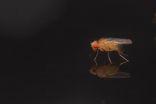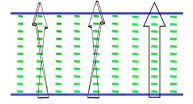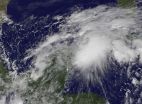INFORMATION:
Carolina Bravo, Luis Miguel Bautista, Mario García-Paris, Guillermo Blanco and Juan Carlos Alonso. Males of a strongly polygynous species consume more poisonous food than females, PLOS ONE. Doi: 10.1371/journal.pone.0111057
Males of great bustard self-medicate to appear more attractive to females
Males take poison not only to eliminate parasites, but also to look healthier and stronger to females and to achieve a greater reproductive success
2014-10-22
(Press-News.org) Males of great bustard consume small doses of poison with a dual purpose: to eliminate intern parasites and, especially, to look healthier and stronger before females, allowing them to achieve a greater reproductive success. A team of researchers from the Spanish National Research Council has now suggested for the first time that this function of self-medication could be a mechanism of sexual selection. The study results are published in the PLOS ONE journal.
Juan Carlos Alonso, who led the project, CSIC researcher at the Department of Evolutive Ecology of the Spanish National Museum of Natural Sciences, explains that: "The team of researchers has discovered that the great bustards consume two species of blister beetles (Berberomeloe majalis and Physomeloe corallifer) that are avoided by most predators due to their content of cantharidin, a very toxic compound that in small doses can kill most animals, including man.
Alonso explains that this behavior of the great bustard is because some animals have evolved the ability to tolerate toxics, and even to use them as medicine against infections. This adaptation, innately developed in this animals, is known as self-medication. In fact, cantharidin has a potent antibacterial and anthelmintic effectiveness, so bustards can use it as medicine against gastrointestinal infections caused by bacteria, tapeworms and nematodes, which are frequent in these birds and can be transmitted sexually.
Both males and females consume these blister beetles, but only males chose them among all the available insects. Actually, males consume them in a larger quantity and size than females. Alonso states that "they eagerly look for them in spring, when the stress produced by the hard mating behavior and the strong competition among males to access to females make them more vulnerable to infections". The authors of the study suggest that great bustard males use cantharidin to reduce their parasite load in order to look healthier, stronger, and thus more attractive for females.
This consumption would explain why males display their cloaca (the cloaca is the final opening of the digestive tract in birds, but also the excretory organ of their urinary system, and their copulatory organ in the absence of a penis) when they approach females, and why females conduct such a meticulous inspection of the males cloaca.
Alonso asserts that "the white plumage surrounding the cloaca allows the female to clearly visualize if the area coming into contact during copulation is free of parasites or signs of their presence, such as dirt produced by diarrhea. The importance of choosing the healthiest, strongest and best capable male to withstand the effects of cantharidin gives full meaning to the scrupulous inspection conducted by a female among several males before choosing a consort".
Alonso considers that "this function of self-medication was never before suggested or investigated as a mechanism involved in the process of sexual selection. However, self-medication could be of great importance, especially in polygamous species, in which competition among males is specially intense, and females are the ones that choose the male that will fertilize them".
The authors explain that self-medication can be a significant mechanism involved in the process of sexual selection. Just like male peacocks have developed longer tail feathers with the sole purpose of attracting females, assuming the consequent burden when they have to escape predators, the male of great bustard assumes the risk of consuming a highly toxic product, not only to get rid of parasites but also to show females that is resistant to toxicity, and that this resistance can be transmitted to their offspring.
ELSE PRESS RELEASES FROM THIS DATE:
Baby cries show evidence of cocaine exposure during pregnancy
2014-10-22
A new study conducted by University of North Carolina School of Medicine researchers provides the first known evidence of how a similar acoustic characteristic in the cry sounds of human infants and rat pups may be used to detect the harmful effects of prenatal cocaine exposure on nervous system development.
"These findings are important because studies of prenatal drug exposure in humans are always limited by not knowing if infant nervous system damage was due to the effects of a specific drug, such as cocaine, or the effects of other associated factors, such as maternal ...
Secret wing colors attract female fruit flies
2014-10-22
Bright colours appear on a fruit fly's transparent wings against a dark background as a result of light refraction. Researchers from Lund University in Sweden have now demonstrated that females choose a mate based on the males' hidden wing colours.
"Our experiment shows that this newly-discovered trait is important in female choice in fruit flies, and is the first evidence that wing interference patterns have a biological signalling function between the sexes during sexual selection", said Jessica Abbott, a biologist at Lund University.
The extremely thin wings of the ...
Hospital logs staggering 2.5 million alarms in just a month
2014-10-22
Following the study of a hospital that logged more than 2.5 million patient monitoring alarms in just one month, researchers at UC San Francisco have, for the first time, comprehensively defined the detailed causes as well as potential solutions for the widespread issue of alarm fatigue in hospitals.
Their study is in the Oct. 22 issue of PLOS ONE and available online.
The issue of alarm fatigue has become so significant that The Joint Commission, a national organization that accredits hospitals, named it a National Patient Safety Goal. This goal requires hospitals ...
New 3-D display technology promises greater energy efficiency
2014-10-22
WASHINGTON, Oct. 22, 2014—At first glance, the static, greyscale display created by a group of researchers from the Hong Kong University of Science and Technology, China might not catch the eye of a thoughtful consumer in a market saturated with flashy, colorful electronics. But a closer look at the specs could change that: the ultra-thin LCD screen described today in a paper in The Optical Society's (OSA) journal Optics Letters is capable of holding three-dimensional images without a power source, making it a compact, energy-efficient way to display visual information.
Liquid ...
Tropical Depression 9 forms in Gulf of Mexico
2014-10-22
Tropical Depression Nine formed over the western Bay of Campeche, Gulf of Mexico and is forecast to make a quick landfall on Mexico's Yucatan Peninsula. NOAA's GOES-East Satellite captured the birth of the depression.
NOAA's GOES-East Satellite captured an image of the birth of Tropical Depression 9 on Oct. 22 at 1600 UTC (12 p.m. EDT) in the western Bay of Campeche. The clouds associated with the depression stretched over the Yucatan Peninsula and into the western Caribbean Sea.
On Oct. 22, a Tropical Storm Warning was in effect from Celestun to Frontera, Mexico. The ...
Two families of comets found around nearby star
2014-10-22
Beta Pictoris is a young star located about 63 light-years from the Sun. It is only about 20 million years old and is surrounded by a huge disc of material — a very active young planetary system where gas and dust are produced by the evaporation of comets and the collisions of asteroids.
Flavien Kiefer (IAP/CNRS/UPMC), lead author of the new study sets the scene: "Beta Pictoris is a very exciting target! The detailed observations of its exocomets give us clues to help understand what processes occur in this kind of young planetary system."
For almost 30 years ...
Recently discovered microbe is key player in climate change
2014-10-22
Tiny soil microbes are among the world's biggest potential amplifiers of human-caused climate change, but whether microbial communities are mere slaves to their environment or influential actors in their own right is an open question. Now, research by an international team of scientists from the U.S., Sweden and Australia, led by University of Arizona scientists, shows that a single species of microbe, discovered only very recently, is an unexpected key player in climate change.
The findings, published in the journal Nature, should help scientists improve their simulations ...
Research reveals how lymph nodes expand during disease
2014-10-22
CANCER RESEARCH UK and UCL scientists have discovered that the same specialised immune cells that patrol the body and spot infections also trigger the expansion of immune organs called lymph nodes, according to a study* published in Nature today (Wednesday).
The immune system defends the body from infections and can also spot and destroy cancer cells. Lymph nodes are at the heart of this response, but until now it has never been explained how they expand during disease.
The researchers – at Cancer Research UK's London Research Institute – found that when ...
Fast modeling of cancer mutations
2014-10-22
Sequencing the genomes of tumor cells has revealed thousands of genetic mutations linked with cancer. However, sifting through this deluge of information to figure out which of these mutations actually drive cancer growth has proven to be a tedious, time-consuming process.
MIT researchers have now developed a new way to model the effects of these genetic mutations in mice. Their approach, based on the genome-editing technique known as CRISPR, is much faster than existing strategies, which require genetically engineering mice that carry the cancerous mutations.
"It's ...
Thermal receipt paper may be a potentially significant source of BPA
2014-10-22
Thermal paper, sometimes used in cash register receipts, may be a potential source of exposure to the hormone disruptor bisphenol-A (BPA), according to a study published October 22, 2014 in the open-access journal PLOS ONE by Annette Hormann from University of Missouri and colleagues.
Results showed that when men and women handled a thermal receipt after using a hand sanitizer, there was a very large amount of BPA transferred from the receipt to the hand, resulting in a rapid increase in blood levels of BPA.
Bisphenol A (BPA) is used in a wide variety of products, and ...
LAST 30 PRESS RELEASES:
Heart-brain connection: international study reveals the role of the vagus nerve in keeping the heart young
Researchers identify Rb1 as a predictive biomarker for a new therapeutic strategy in some breast cancers
Survey reveals ethical gaps slowing AI adoption in pediatric surgery
Stimulant ADHD medications work differently than thought
AI overestimates how smart people are, according to HSE economists
HSE researchers create genome-wide map of quadruplexes
Scientists boost cell "powerhouses" to burn more calories
Automatic label checking: The missing step in making reliable medical AI
Low daily alcohol intake linked to 50% heightened mouth cancer risk in India
American Meteorological Society announces Rick Spinrad as 2026 President-Elect
Biomass-based carbon capture spotlighted in newly released global climate webinar recording
Illuminating invisible nano pollutants: advanced bioimaging tracks the full journey of emerging nanoscale contaminants in living systems
How does age affect recovery from spinal cord injury?
Novel AI tool offers prognosis for patients with head and neck cancer
Fathers’ microplastic exposure tied to their children’s metabolic problems
Research validates laboratory model for studying high-grade serous ovarian cancer
SIR 2026 delivers transformative breakthroughs in minimally invasive medicine to improve patient care
Stem Cell Reports most downloaded papers of 2025 highlight the breadth and impact of stem cell research
Oxford-led study estimates NHS spends around 3% of its primary and secondary care budget on the health impacts of heat and cold in England
A researcher’s long quest leads to a smart composite breakthrough
Urban wild bees act as “microbial sensors” of city health.
New study finds where you live affects recovery after a hip fracture
Forecasting the impact of fully automated vehicle adoption on US road traffic injuries
Alcohol-related hospitalizations from 2016 to 2022
Semaglutide and hospitalizations in patients with obesity and established cardiovascular disease
Researchers ‘listen in’ to embryo-mother interactions during implantation using a culture system replicating the womb lining
How changing your diet could help save the world
How to make AI truly scalable and reliable for real-time traffic assignment?
Beyond fragmented markets: A new framework for efficient and stable ride-pooling
Can shape priors make road perception more reliable for autonomous driving?
[Press-News.org] Males of great bustard self-medicate to appear more attractive to femalesMales take poison not only to eliminate parasites, but also to look healthier and stronger to females and to achieve a greater reproductive success





